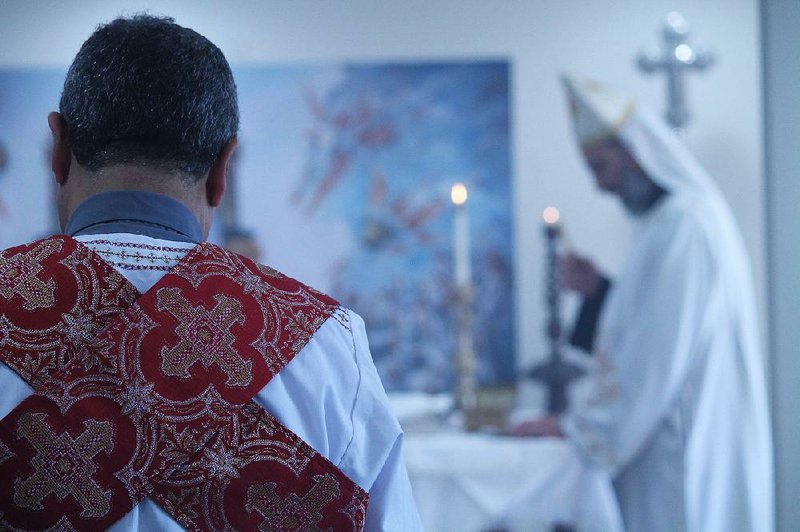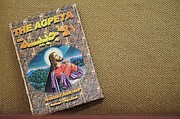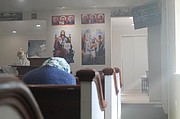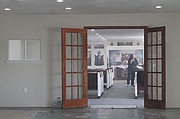Inside the one-story building still bearing its convenience-store sign at the curb, pastor James Gendi began his sermon.
"The opening of a new church is always an exciting time," the priest said. "We see God's hand in our work, and oftentimes it's easy -- amidst the blessing as well as the chaos -- to lose track of what really is the purpose and meaning of having a church building in a community."
After standing for most of the nearly three-hour worship service, the 20 people in the new St. George Coptic Orthodox Church in Little Rock finally took their seats. After more than two decades of gathering in rented churches with as few as three families, the lone Coptic Christian congregation in Arkansas gathered Nov. 17 to worship for the first time in the state's first church devoted to the Coptic faith.
"So they say actually the church is the heaven on Earth, right?" Gendi continued. "And what makes the church heaven? Is it ... the nice design of the church, the beautiful icons?"
Someone murmured an answer from the pews.
"The presence of God, absolutely," Gendi said. "It's the presence of God dwelling among his people. This was something that God desired from the very beginning, is to dwell among his people."
ANCIENT FAITH
Coptic Orthodoxy is one of the most ancient forms of Christianity. Founded around A.D. 43 in Egypt, the faith is believed to have been founded by St. Mark the Apostle, who then led the church as the first Pope of Alexandria.
Copts -- as believers are also called -- make up the largest Christian population in the Middle East, according the Harvard Divinity School's Religious Literacy Project. In Egypt, they account for most of the country's 9 million Christians -- 10 percent of the country's population.
In the United States, half a percent of the 35,000 people surveyed for the Pew Research Center's 2014 Religious Landscape identified as followers of Orthodox Christianity, within which the religion is classified.
Coptic Christians believe the divine and human aspects of Jesus are united in one nature, rather than as an incarnation of Jesus "without mingling, without confusion, and without alteration," according to the faith's liturgy. The distinction split Copts from other forms of Orthodox Christianity in A.D. 451.
Services are carried out at St. George in English, Arabic and Coptic -- the latter of which is an ancient Egyptian language that is now almost exclusively a liturgical language for the church.
In the faith, priests can marry and usually are called to service while working in another field. Before answering the call to service in the faith and eventually being ordained as a priest in 2011, Gendi was a registered pharmacist. His Grace Bishop Youssef, the leader of the Coptic church's Southern United States diocese since 2012, had recently finished a medical residency as an ear, nose and throat specialist in Egypt before being called to ministry.
Coptic Christians believe highly in the value of education. Many church members attain advanced degrees and specialize in the medical field or in engineering, and instill those values in their children.
BUILDING COMMUNITY
Raef Tadros and his wife, Nahed, have been members of the St. George community the longest.
Raef Tadros, a chemical engineer, came to the United States in 1988 to study in Nebraska, and with other members of the community established a church in Council Bluff, Iowa, in 1997 before moving to Arkansas in 1999.
With as few as three families, Tadros said, the group in Little Rock rented space in various churches in which to worship. Services have taken place for the past 15 years in the sanctuary of Little Rock's Chenal Valley Church, devoted to worshippers of the Church of Christ denomination.
"They were really good people, really supportive," Tadros said of those at Chenal Valley Church. "They really opened their arms for us."
Gendi -- a priest at St. Mary and Archangel Michael Coptic Orthodox Church in Houston -- has flown to Little Rock on Friday evenings in time for service two Saturdays a month, returning to Houston in time to minister to the church there, which numbers about 200 families. There, Gendi said, it takes around two hours for everyone to take the Lord's supper. In Little Rock, it takes about 15 minutes.
A PLACE TO WORSHIP
When Mina Awadalla and his wife, Neveen Amin, moved from Egypt as students in 2007 to Austin, Texas, there was no Coptic church in the city. The couple became part of an effort that resulted in the building of the first Coptic church in Austin in 2009.
"Because Mina's father is a priest, he knows how important it is to have a place to worship," Amin said.
It was about 2015 -- when the couple moved from Austin to Little Rock so that Amin could take a position as a professor at the University of Arkansas at Little Rock -- that the congregation had begun its search for a place the church could call home.
It took two rejections of applications submitted for other properties in the area before finding the 4,400 square-foot building on Lawson Road, which had housed a convenience store. The effort was further stalled when the bank processing the loan for the church was merged with another bank, which forced a restart of the loan process.
The core group of five families was united in the decision, but for Sara Hanna, who is a member of the church along with her husband, Peter, and their two children, it was hard to imagine.
"Personally, I didn't have a vision for the church, but others had a much better picture," Sara Hanna said.
Amin said it was Sammy Sadaka, a researcher for the University of Arkansas' Division of Agriculture, and Awadalla who envisioned the future church.
The property was closed on in late August, and renovations began right away. The group sent flurries of messages on social media about building materials and meeting for renovations. Church members met around work and school schedules.
"We've had engineers working on top of the roof and doctors working on the floor," Hanna said.
Renovations were largely completed by the time of the Nov. 17 service.
Around a Thanksgiving-style spread and expressions of gratitude to God and one another after the service, Amin spoke of how she and Awadalla had initially questioned their new life in Arkansas.
"We didn't know why God sent us here," Amin said. "We were always questioning, 'Why here?' ... When we moved to Austin in 2007 there was no church, [and] in 2009 we bought a church. And it's actually the same exact story.
"So we feel like God sent us here for a reason. We can see that now."
More information about St. George Coptic Orthodox Church is available online at suscopts.org/diocese/churches/st-george-little-rock.
Religion on 11/24/2018



